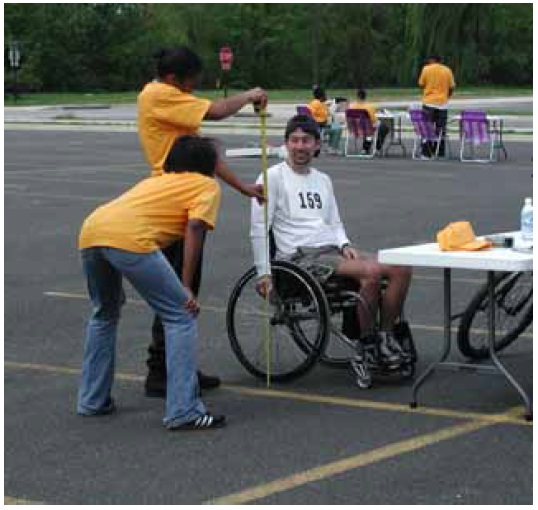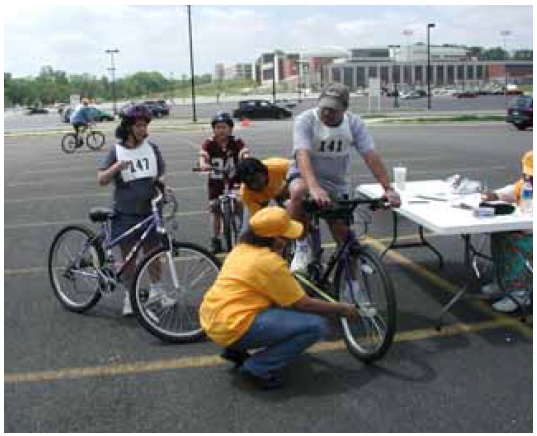Station 1-Physical Characteristics
At the first station, the physical characteristics of active participants and their equipment were measured (figure 26). These included:

Figure 26. Physical measurements.
a. Physical measurements of a wheelchair and rider.

Figure 26. Physical measurements.
b. Physical measurements of a bicycle and rider.
-
Length-measured parallel to the direction of travel, including the user's body, if applicable.
-
Width-measured perpendicular to the direction of travel, including the user's body if it extends beyond the device or vehicle.
-
Height-measured from the ground to the highest point on the device or vehicle or the top of the user's head, whichever is higher.
-
Eye height-measured from the ground to the user's eye location.
-
Wheelbase-measured between the front axle and the rear axle of the device or vehicle.
-
Wheel spacing-measured from the center of one outside wheel to the center of the other outside wheel.
-
Wheel diameter-measured vertically from the point of contact with the ground to the highest point on the wheel.
-
Tire or wheel width.
-
Tire type (pneumatic, polyurethane, solid rubber, etc.)
These physical dimensions can be used by practitioners to provide an assessment of users' operational characteristics and facility design features that are critical to some user groups. For example, pavement condition requirements for a user group depend on the size and type of wheels and tires of the device or vehicle. Large-wheeled vehicles and devices like bicycles and jogging strollers can be used on a variety of pavements. Small-wheeled devices like skateboards, inline skates, and kick scooters are nearly impossible to use on unpaved surfaces and can be uncomfortable and difficult to operate on rough pavements such as chip seal and asphalt with large aggregate. Similarly, pavement condition is a factor in wheelchair travel. Manual and powered wheelchairs that are built to optimize indoor maneuvering will not be as usable in the outdoor environment.
For motorized scooters, wheelchairs, and other assistive devices, the critical measurement is width, which is necessary to determine the minimum clear width for passage. Section 4.2.1 of the ADAAG requires a minimum clear width of 815 mm (32 inches) at a point, and 915 mm (36 inches) continuously, for single wheelchair passage. In addition, Section 4.2.2 of the ADAAG requires that the minimum width for two wheelchairs to pass is 1525 mm (60 inches).
Maneuvering around a turn requires additional space for wheeled devices. Where bollards, fences, gates, or turnstiles restrict access to shared use paths, users may have difficulty getting their devices through the restricted area. The results of this research will help provide facility designers with the information needed to design for both accessibility and safe operation.

User Comments/Questions
Add Comment/Question